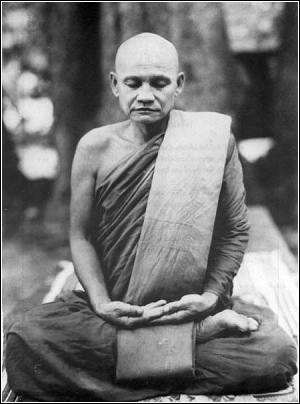Theravada
Theravada, literally “doctrine of the elders,” is the most commonly accepted name of Buddhism's oldest existing school. The school's adherents, termed Theravadins, have preserved their version of Gautama Buddha's teaching in the Pali Canon for over a millennium.
The ideal of Theravada Buddhism is the arhat (Pali: arahant), or perfected saint, who attains enlightenment as a result of his own efforts. The role of the layman and monk are clearly differentiated by the Theravadins, who do not consider it possible to attain enlightenment while one is living the life of a layman. Theravadins profoundly revere the historical Buddha as a perfected master but do not pay homage to the numerous buddhas and bodhisattvas that are worshiped in other Buddhist traditions.
During the early centuries following the death of the Buddha, the Buddhist community broke up into several sects. Members of one the sects were called Vibhajyavadins. Those Vibhajyavadins that were distributed geographically in southern India and Sri Lanka became known as the Theravadins. The Theravada form of Buddhism gradually spread eastward, becoming dominant in Myanmar in the late 11th century and in Cambodia and Laos by the 13th and 14th centuries.
Below is a photo of the Thuparamaya stupa in Sri Lanka. Thuparamaya is believed to be the first temple constructed after Arahat Mahinda, the monk who brought Buddhism to Sri Lanka, arrived Sri Lanka. The temple had been destroyed and rebuilt from time to time.

In the past, other Buddhist traditions disparagingly called Theravada using the term Hinayana (the "Lesser Vehicle") as opposed to Mahayana (the "Greater Vehicle"). To avoid the pejorative tone implied by the terms Hinayana and Mahayana, it is common today to use more neutral language to distinguish between these two main branches of Buddhism. Because Theravada historically dominated southern Asia, it is sometimes called "Southern" Buddhism, while Mahayana, which migrated northwards from India, is known as "Northern" Buddhism.
Below is a photo of almsgiving, which is practiced in some countries of Theravada tradition:

Theravadins accept as authoritative the Pali canon of ancient Indian Buddhism. This includes the nikayas and vinaya pitaka (rules of conducts for monks and nuns). English translation of the nikayas can be found on the nikaya webpage. Below is a book on vinaya. The author, Isaline Blew Horner OBE (30 March 1896 – 25 April 1981), was an English Indologist, a leading scholar of Pali literature and late president of the Pali Text Society (1959–1981). She had published a translation of a part of the Vinaya Pitaka.

A book, written in the 5th century CE by Buddhaghosa in Sri Lanka, is considered the most important Theravada text outside of the Pali canon of scriptures. It is a manual condensing and systematizing the 5th century understanding and interpretation of the Buddhist path as maintained by the elders in Sri Lanka. This is an English translation of the book: The Path of Purification.

Recently Theravada undergoes a period of revival. New approaches develop. One of them is the Thai Forest tradition. Monks of this tradition spend time in forests, caves and cremation grounds to practice meditation. A well respected monk of this approach was Ajahn Chah (1918-1992). He was instrumental in establishing Theravada Buddhism in the West. More than one million people, including the Thai royal family, attended Ajahn Chah's funeral. Below is a picture of Ajahn Chah:

Below are books written by practitioners of this tradition:
(1) The Teachings of Ajahn Chah (a collection of Ajahjn Chah's dhamma talks)

(2) Forest Dhamma by Ajahn Maha Bua (1913-2011)

(3) Parami Ways to Cross Life's Floods by Ajahn Sucitto

(4) Meditation - An Outline also by Ajahn Sucitto
